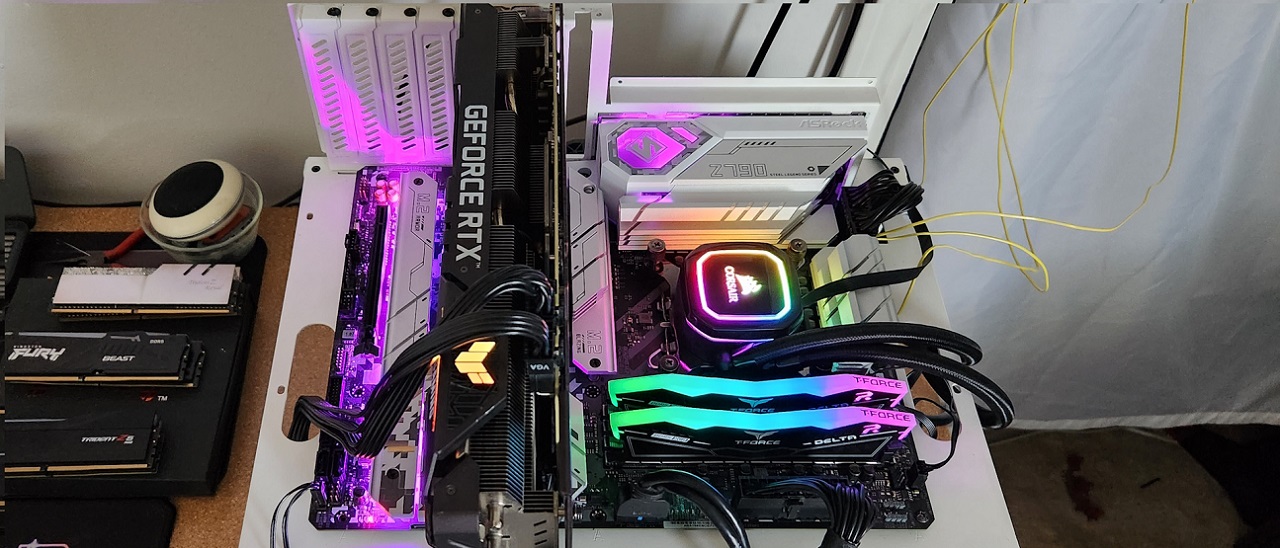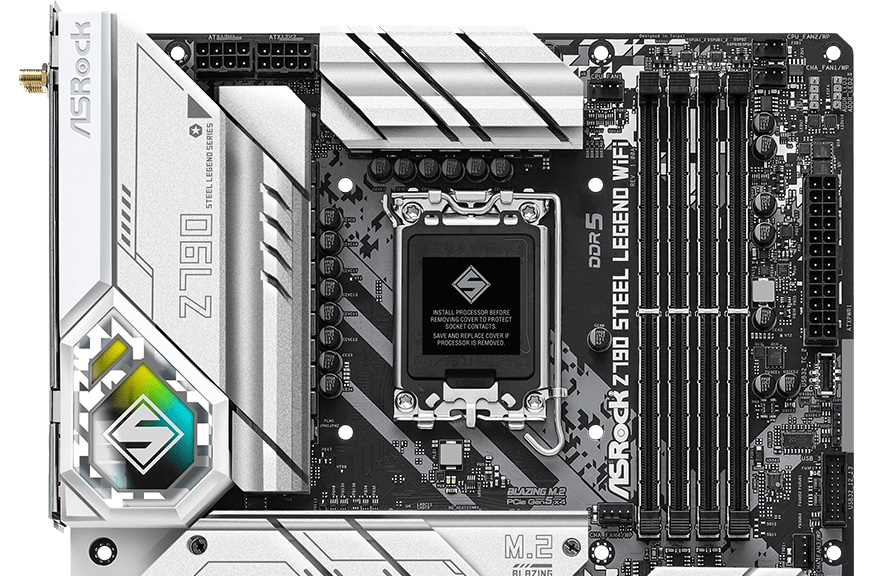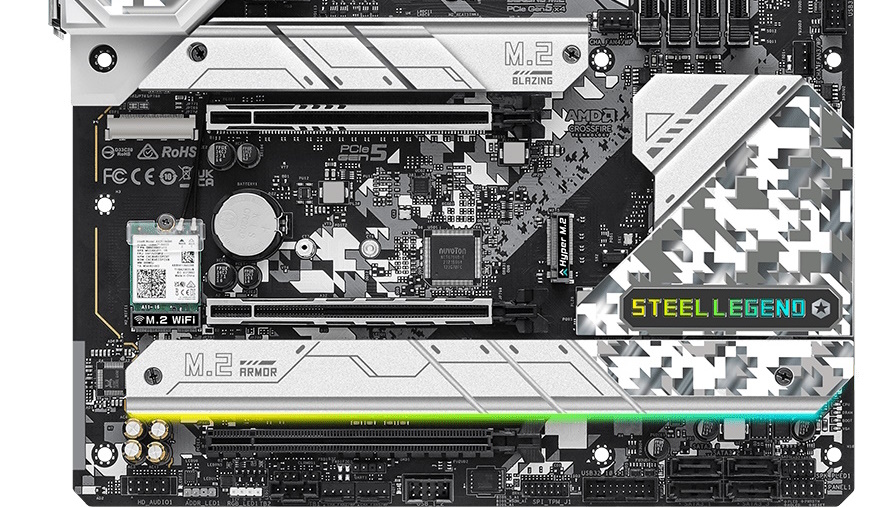Tom's Hardware Verdict
ASRock’s $229.99 Z790 Steel Legend, is a value-oriented Intel option sporting a black-on-silver theme and bright RGBs. It includes everything you’d expect from a budget ATX board. Performance in our testing was limited in heavily multi-threaded and long-running workloads out of the box (thermal throttling) with our i9-13900K, but was competent everywhere else, including gaming.
Pros
- +
Five M.2 sockets (one PCIe 5.0)
- +
Eight SATA ports
- +
20 Gbps Type-C port (Front)
- +
eDP port
Cons
- -
Only 4 M.2 sockets run concurrently
- -
Audio codec could be better
Why you can trust Tom's Hardware
ASRock’s Z790 Steel Legend is a full-size ATX motherboard supporting Intel’s 12th and 13th-generation processors. With a current (at the time of this writing) price of $229.99, it’s an affordable option in the Z790 space. You get an attractive black-with-silver highlights appearance and integrated RGB lighting. Specs-wise, there are plenty of storage options, including five total M.2 sockets and eight SATA ports, fast networking and integrated Wi-Fi 6E, DDR5 support up to DDR5-7200+(OC), the unique eDP port (for internal displays), and a dated budget audio codec. In all, it’s a solid choice in the budget Z790 space.
Specifications-wise, the Steel Legend compares well against the competition regarding hardware. Starting with power delivery, you get 16 phases dedicated to Vcore along SPS-type MOSFETs that easily handle the additional stress of overclocking, copious amounts of storage including five M.2 sockets (one PCIe 5.0), plenty of USB ports on the rear IO, a PCIe 5.0 slot, and a 20 Gbps Type-C port for the front panel. On the performance front, the Steel Legend was around average, depending on the test, though none of the results were worrisome or out of line.
Below, we’ll dig into the details of the board and see if the Steel Legend has what it takes to find its way onto our Best Motherboards list – but ppoiler: it’s a good one! Before we get into our testing and board details, though, we’ll start by listing the specifications from ASRock.
Specifications: ASRock Z790 Steel Legend
| Socket | LGA1700 |
| Chipset | Z790 |
| Form Factor | ATX |
| Voltage Regulator | 18 Phase (16x 60A SPS MOSFETs for Vcore) |
| Video Ports | (1) HDMI (v2.1) |
| (1) DisplayPort (v1.4) | |
| (1) eDP (v1.4) | |
| USB Ports | (1) USB 3.2 Gen 1 (10 Gbps), Type-C |
| (1) USB 3.2 Gen 1 (10 Gbps) | |
| (8) USB 3.2 Gen 1 (5 Gbps) | |
| Network Jacks | (1) 2.5 GbE |
| Audio Jacks | (5) Analog |
| (1) SPDIF | |
| Legacy Ports/Jacks | ✗ |
| Other Ports/Jack | ✗ |
| PCIe x16 | (1) v5.0 (x16) |
| (1) v4.0 (x4) | |
| (1) v3.0 (x2) | |
| PCIe x8 | ✗ |
| PCIe x4 | ✗ |
| PCIe x1 | ✗ |
| CrossFire/SLI | ✗ |
| DIMM Slots | (4) DDR5 7200+(OC)*, 192GB Capacity |
| 1DPC 1R Up to 7200+ MHz (OC), 4800 MHz Natively. | |
| 1DPC 2R Up to 6000+ MHz (OC), 4400 MHz Natively. | |
| 2DPC 1R Up to 5600+ MHz (OC), 4000 MHz Natively. | |
| 2DPC 2R Up to 4800+ MHz (OC), 3600 MHz Natively. | |
| M.2 Sockets | (1) PCIe 5.0 x4 (64 Gbps) / PCIe (up to 80mm) |
| (4) PCIe 4.0 x4 (64 Gbps) / PCIe (up to 80mm) | |
| SATA Ports | (8) SATA3 6 Gbps (Supports RAID 0/1/5/10) |
| USB Headers | (1) USB v3.2 Gen 1, Type-C (5 Gbps) |
| (1) USB v3.2 Gen 1 (5 Gbps) | |
| (1) USB v2.0 (480 Mbps) | |
| Fan/Pump Headers | (5) 4-Pin (CPU, CPU/Water Pump, Chassis/water pump) |
| RGB Headers | (3) aRGB (3-pin) |
| (1) RGB (4-pin) | |
| Diagnostics Panel | (1) Post Status Checker (4 LEDs) |
| Internal Button/Switch | ✗ |
| SATA Controllers | Asmedia ASM1061 |
| Ethernet Controller(s) | (1) Realtek Dragon RTL8125BG (2.5 GbE) |
| Wi-Fi / Bluetooth | Intel Wi-Fi 6E (2x2, MU-MIMO, ax, BT5.3) |
| USB Controllers | (2) ASMedia ASM1074 |
| HD Audio Codec | Realtek ALC897 |
| DDL/DTS | ✗ / ✗ |
| Warranty | 3 Years |
Inside the Box of the ASRock Z790 Steel Legend
Inside the retail box is a small handful of accessories. ASRock includes the basics as expected from a budget motherboard, but not much more.
- User Manual
- Two SATA cables
- ASRock WiFi 2.4/5/6 GHz antenna
- Four Screws for M.2 Sockets
- Graphics Card Holder
Design of the Steel Legend
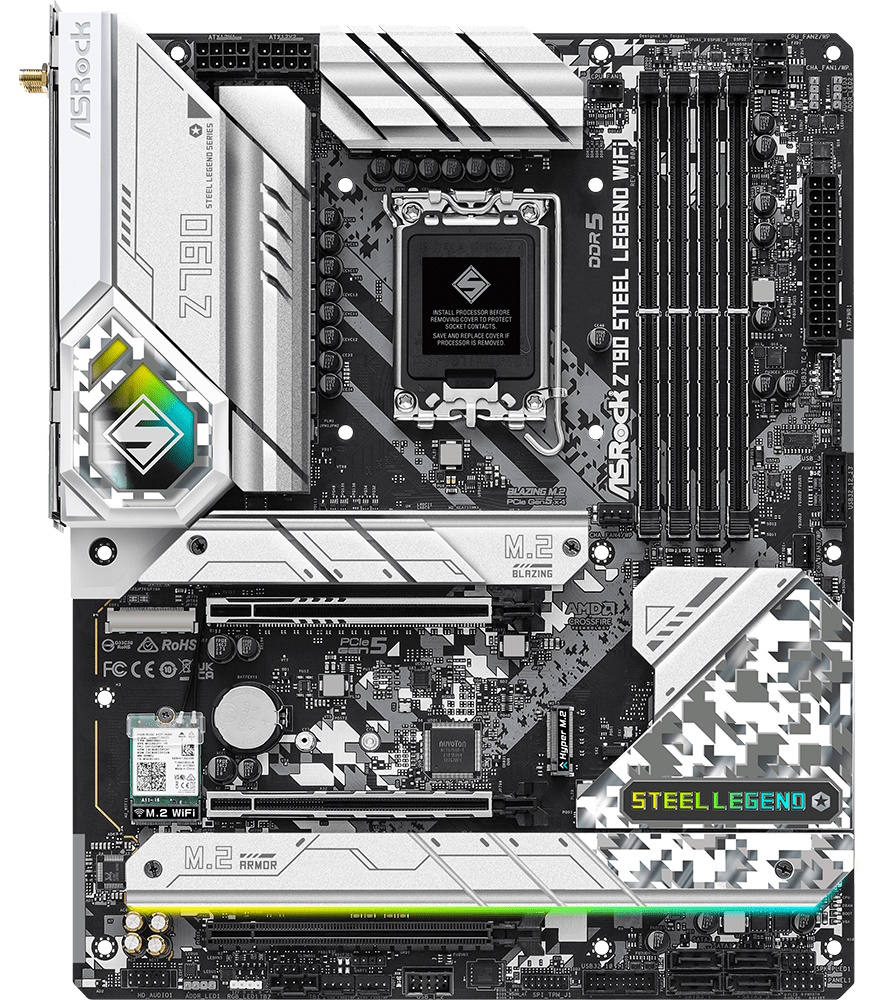
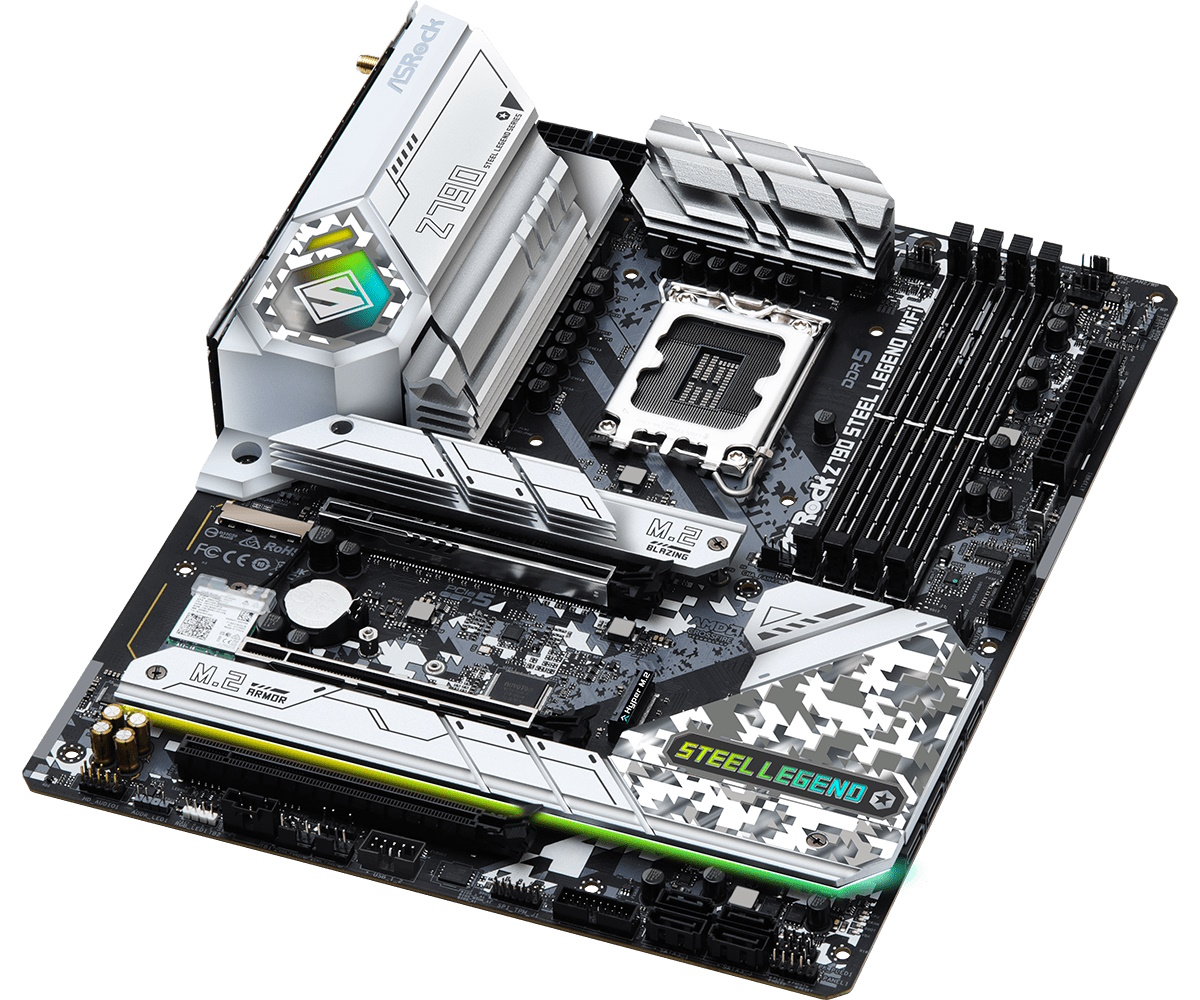
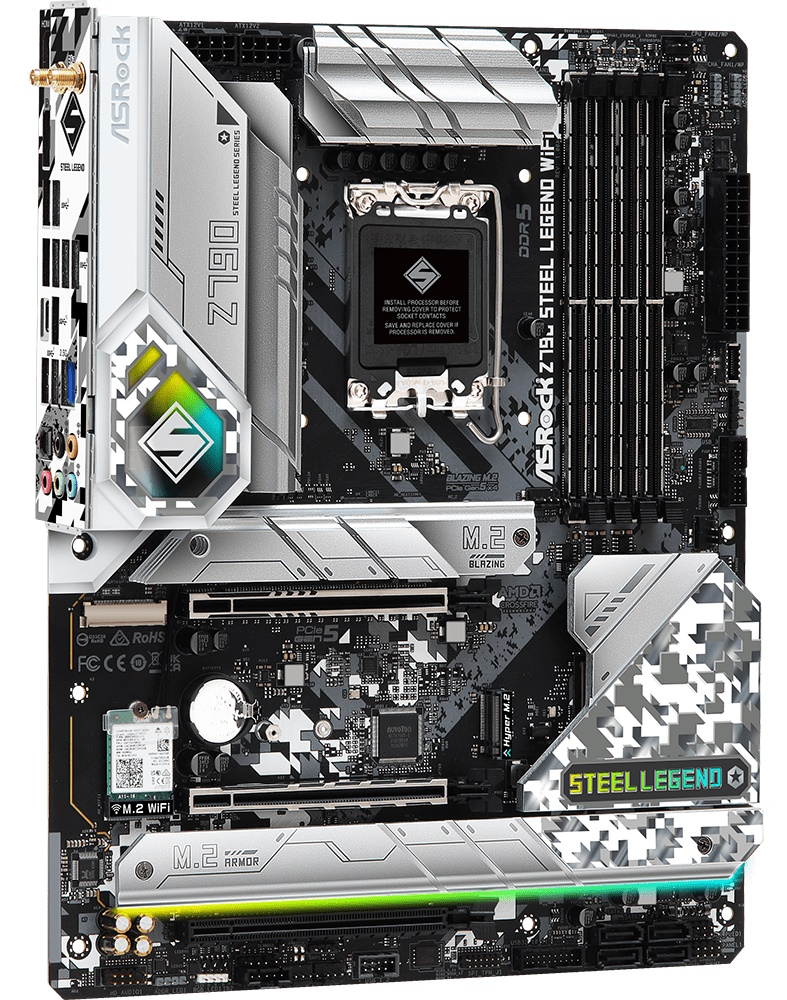
The Z790 Steel Legend sits on a matte-black, 6-layer PCB with several reinforced slots, silver heatsinks, and black, white, and gray digital camouflage highlights in several areas. Overall, it looks good, but it gives off a budget vibe as there is a lot of PCB showing (not online other similarly priced models). If you’re interested in integrated RGB lighting, the Steel Legend has plenty of them in two spots: the IO area and under the M.2, and chipset heatsinks along the bottom. Control over the lighting is handled through the BIOS or ASRock’s Polychrome Sync Application. The RGB lighting on this board is bright and saturated and will surely bring attention to your system. Again, we like the look, and it looks good in many themed builds, but the design doesn’t scream high-end.
Starting in the upper-left corner, the first thing we see among the heatsinks are the two 8-pin EPS connectors (one required) to power the processor. The silver VRM heatsinks surrounding them stand much taller and have plenty of mass and surface area to keep the power bits below running within spec. The cover over the IO bits has ASRock branding and the Steel Series “S” illuminated from below by RGB LEDs.
Moving past the socket area and to the left of the DRAM slots are the first two (of seven) 4-pin fan headers. Each header supports PWM and DC-controlled devices ranging from 1A/12W (CPU_FAN1) to 2A/24W (remainder), so you have enough power to support several devices. Just be sure not to overload them. Control over these headers is handled through the BIOS or the A-Tune application.
Get Tom's Hardware's best news and in-depth reviews, straight to your inbox.
To the right of the socket are four reinforced DRAM slots with locking mechanisms on both sides. ASRock lists support up to DDR5-7200+(OC), but your mileage may vary. We had no issues with our three kits, including our fastest, the Teamgroup DDR5-7200 set, which isn’t on the QVL list. ASRock, in general, has done a good job with memory compatibility on this platform, and it doesn’t change with the Steel Legend.
Past the DRAM slots are two more 4-pin fan headers and the first RGB headers, two 3-pin ARGB. Two additional headers are found at the bottom of the board. You get another 3-pin ARGB (three total) below, plus the only 4-pin RGB header. Remember: You control these through the BIOS or the Polychrome Sync app. Continuing down the right edge, we run into the 24-pin ATX connector to power the board, the front panel USB 3.2 Gen 2x2 (20 Gbps) Type-C port, a front panel USB 3.2 Gen 1 (5 Gbps) port, and another 4-pin fan header.
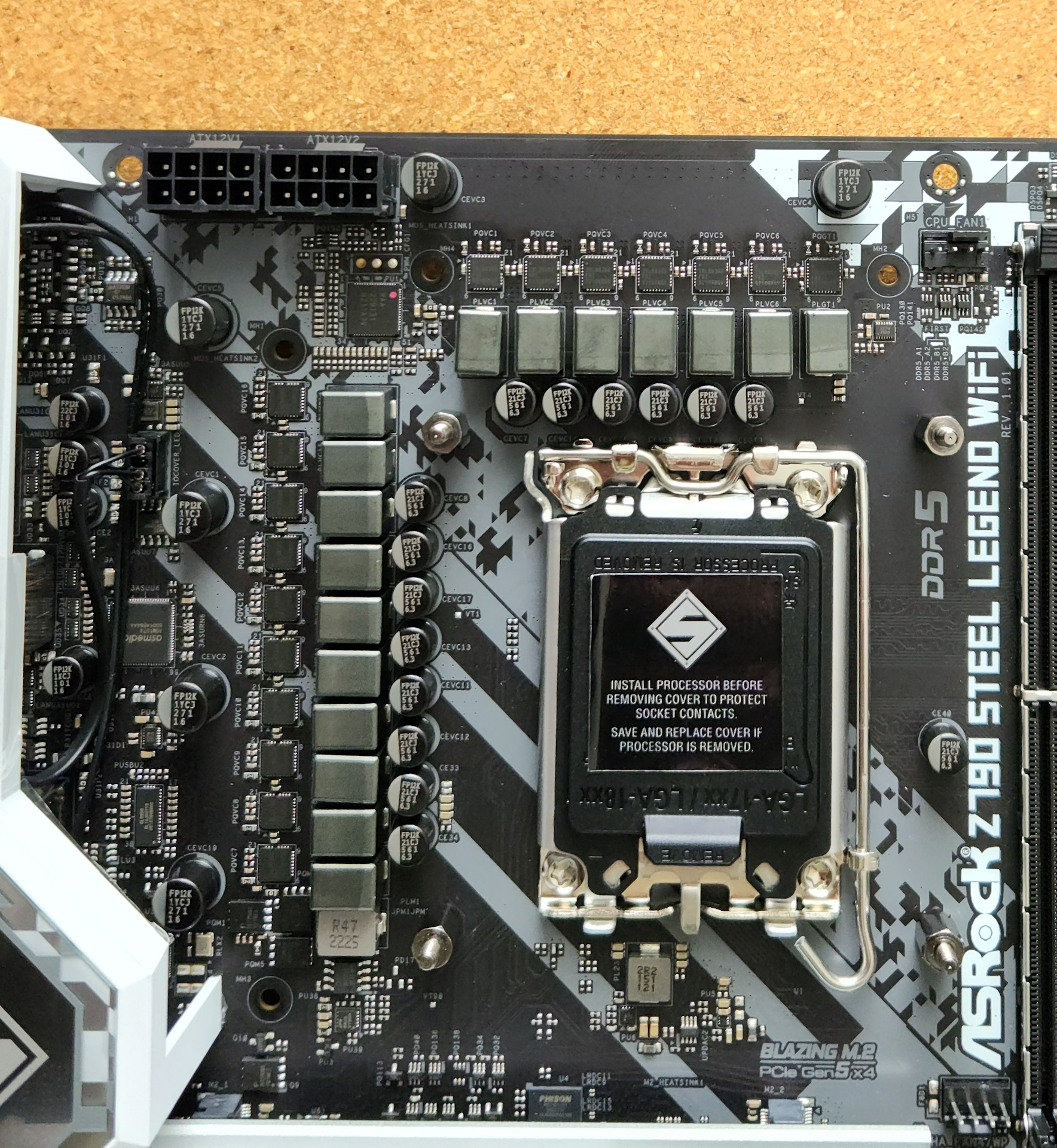
ASRock lists Power delivery on the Steel Legend at 18 total phases, with 16 dedicated to Vcore. Power comes from the 8-pin EPS connector and heads down to the Renesas RAA229131 PWM controller. Next are the 16 60A Intersil ISL99360 SPS MOSFETs dedicated to Vcore, using a Teamed configuration. The 960A available isn’t ground-breaking, but it still handled our Intel Core i9-13900K during testing at stock and while overclocked. Your cooling will get in the way before the power delivery across most boards, so you’re all set.
On the bottom half of the board are three full-length PCIe slots and a whopping five M.2 sockets. Starting on the left edge is a fully exposed audio section with the budget Realtek ALC897 codec visible and four audio capacitors. The codec certainly isn’t the best, but seeing it at this price is common. Another neat add-on in this area (above the audio and M.2 Wi-Fi Key-E socket) is the eDP connector that sits above the audio area. This port you to add displays that support the connector to extend your desktop to a screen inside your case. The ASRock 13.3” side panel kit is a natural fit.
In the middle of the board, we’ll start with the PCIe slots, of which there are three total. The top two slots use reinforcement to mitigate the shearing potential of heavy video cards and said to be effective against EMI mitigation. The top slot (PCIE1) connects through the CPU and is your primary graphics slot running at PCIe 5.0 x16 speeds. The second slot (PCIE2) connects through the chipset and runs up to PCIe 4.0 x4 speeds. Lastly, the bottom unreinforced slot (PCIE3) also connects through the chipset and runs up to PCIe 3.0 x2 speeds.
Wedged in, around, and between these slots are five M.2 sockets. You can only use four concurrently due to their physical orientation (and wiring). It’s one or the other. M2_1 is the PCIe 5.0 x4 (128 Gbps) capable socket, while the second runs PCIe 4.0 x4 (64 Gbps). The other three sockets connect through the chipset and run up to PCIe 4.0 x4 (64 Gbps). These all hold up to 80mm modules and support RAID0/1/5 modes for NVMe storage devices. With M2_2 occupied, PCIE1 drops to x8 mode, so you lose a little bandwidth on the primary graphics port, but nothing to worry about unless you’re trying to break overclocking records.
Moving right, we go past the chipset area to the edge that houses four of the eight SATA ports. You can populate all of these ports simultaneously, and all work. The other four ports are found on the bottom edge and mounted vertically. If you want to RAID your SATA drives, the board supports RAID0/1/5/10 modes.
Across the bottom of the board are several exposed headers. You’ll find the usual, including additional USB ports, RGB headers, and power/reset buttons. Below is a complete list from left to right.
- Front panel audio
- 3-pin ARGB header
- 4-pin RGB header
- Thunderbolt AIC header
- Clear CMOS jumper
- (2) System Fan headers
- USB 2.0 header
- TPM header
- (4) SATA3 6 Gbps ports
- System panel header
The rear IO plate on the Z790 Steel Legend comes preinstalled on the motherboard, which is still a nice touch at this price (though increasingly common these days). The Steel Legend theme continues here, with a black-and-white background with black labels on the ports. There are 10 USB ports scattered across the rear IO. You get one USB 3.2 Gen 2 (10 Gbps) Type-C port, a Type-A 10 Gbps port, and eight other USB 3.2 Gen 1 (5 Gbps) ports. For video, the Steel Legend sports HDMI and DisplayPorts for those who want to use the integrated graphics on the processor. Last up is the 2.5 GbE port, Wi-Fi connections, and the 5-plug analog plus SPDIF output for the audio stack.
MORE: Best Motherboards
MORE: How To Choose A Motherboard
MORE: All Motherboard Content

Joe Shields is a staff writer at Tom’s Hardware. He reviews motherboards and PC components.
-
ocer9999 Good looking motherboard, as long as the VRMs can keep up with the CPU, the performance will be just like most other.Reply -
Mason2501 Reply
Got this mb in October 2022 for my am5 7950x build. Note expo Memory only works in single or pair dd5 chips. So if use all slots you won’t be to use the expo oc settings. Without updating the mb bios those settings can harm x3d CPUs. ASRock does have beta bios that fixes the cpu/ram voltage issue. At some I’ll swap out my 4 16gb ram for two 32gb ram sticks. I just stayed with my 7950x cpu that and RTX 4090 it’s an epic gaming pc. Built in sound is hifi ok and can virtual 3D audio. Plenty of fans and rgb connections. Have three m.2 drives. Pick an li lan 216 rgb white case. ASRock Z790 Steel Legend looks great. Drivers are now stable for windows 11.Admin said:The ASRock Z790 Steel Legend ($229.99) is an affordable option for Intel 12th and 13th-gen processors. The board includes five M.2 sockets (one PCIe 5.0), eight SATA ports, 2.5 GbE and Wi-Fi 6E, capable power delivery, and a budget audio codec. Gaming performance is great, but other tasks were average at best.
ASRock Z790 Steel Legend Review: Legendary for Budget Builds : Read more -
chrysalis I own the z690 version of this board and I find what they did on this version really interesting.Reply
The reason I picked the z690 steel legend is I felt the way they drifted away from the way the industry is going was nice for me, it has extra pcie connectivity which is important for me and kept 8 sata ports.
Now this z790 version, has significantly nerfed the pcie connectivity. On the z690 board you have 2 1x pcie slots, and 3 16x slots, the 3 16x slots run in x16, x4, x4 respectively. I use the second 1x slot for my soundcard, and the 3rd pcie x16 slot (x4) for my pcie SSD which requires 4 lanes.
On the z790 board this isnt possible, the x1 slot I use is removed, and the 3rd x16 slot is only x2 lanes, first time I ever seen a x16 slot on a board only give x2 lanes. Change likely forced by intel's changes which removed 8 gen 3 lanes from the chipset.
The z790 version has a nice change where they added 3 extra type A usb ports, the z690 board is mediocre with only 5, however its another give and take, they removed bios flashback from the z790 board which is there and I used it already on the z690 board.
Finally the z690 board has what I think is a design flaw with the placement of the m.2 wifi slot, any modern 2+ slot GPU will cover it up and cause issues with the fragile wifi antennae cables, I had to be really careful slotting in my gpu, they seem to have realised this on the z790 board as they changed the placement of the slot so the end of the card wont be under the GPU. How they didnt discover this before shipping the Z690 board I dont know.
